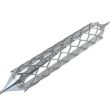There is little evidence to support the safety and efficacy of bioresorbable scaffolds (BRS) for the treatment of chronic total occlusions (CTO). This multicenter registry included consecutive patients with CTO receiving BRS (Absorb; Abbott Vascular) vs. 2nd generation drug eluting stents (DES). Primary end point was target vessel failure at long term (composite...
Patients with Plaque Erosion: Management without Stenting
This small study presented at ESC and simultaneously published in the European Heart Journal evaluated patients undergoing acute coronary syndrome caused by plaque erosion identified by optical computed tomography (OCT). The study showed it can be managed with conservative antithrombotic therapy and without stenting. Patients with plaque erosion can receive dual antiplatelet therapy, ticagrelor and aspirin...
Current Bare-Metal Stents: Similar to DES in the Very Long-Term
The largest randomized trial in history found no difference in the primary endpoint of death and nonfatal infarction between current conventional stents and drug-eluting stents at over 5 years in patients with stable or unstable coronary disease. As expected, NORSTENT did find a difference in revascularization rates between both groups. This study presented at the...
Prevention of Stroke: Carotid Artery Stenting or Endarterectomy?
Original Title: Long-Term Outcome after Carotid Artery Stenting. A Population-Based Matched Cohort Study. Reference: Stroke. 2016 Jul 12. [Epub ahead of print]. In the prevention of stroke, carotid artery stenting (CAS) is far less invasive than endarterectomy, but its long term outcomes remain unclear. This large cohort study compared the long term outcomes of...
Stent Fracture: More Frequent than Expected
Original Title: Incidence and Clinical Outcome of Stent Fractures on the Basis of 6555 Patients and 16482 Drug Eluting Stents From 4 Centers. Reference: Kan J et al. JACC Cardiovasc Interv. 2016 Jun 13;9(11):1115-23. Courtesy of Dr. Guillermo Migliaro. Stent fracture (SF) has been associated with instent restenosis (ISR), stent thrombosis (ST) and repeat revascularization...
Instent restenosis: Drug eluting balloons or drug eluting stents?
Original Title: Long-Term Results of Everolimus-Eluting Stents versus Drug-Eluting Balloons in Patients with Bare-Metal In-Stent Restenosis 3-Year Follow-Up of the RIBS V Clinical Trial. Reference: Alfonso F. et al. JACC Cardiovasc Interv. 2016 Jun 27;9(12):1246-55. Courtesy of Dr. Agustín Vecchia. RIBS V 3 year follow up Stents have become the gold standard for...
Stent thrombosis: Comparative analysis between BMS, DES and BRS
Original Title: Stent Thrombosis with Drug Eluting Stents and Bioresorbable Scaffolds. Evidence from a Network Meta-Analysis of 147 trials. Reference: Kang S et al. J Am Coll Cardiol Intv 2016 doi 10.1016. Courtesy of Dr. Guillermo Migliaro. When treating heart disease, drug eluting stents (DES) have become essential for PCI. Its main advantage lies on...
LEADERS FREE ACS: Biolimus coated stent vs. bare metal stent in ACS with high bleeding risk
Original Title: Biolimus A9 drug-coated stent vs. bare metal stent in patients presenting with ACS. A pre-specified LEADERS FREE ACS sub-study. Presenter: C.K. Naber. In ACS patients with high bleeding risk, guidelines recommend 3 to 6 months of dual ATP treatment for DES implantation or one month in case of conventional stenting. The...
LV: Everolimus Eluting Stents vs. Coronary Artery Bypass Graft
Original Title: Revascularization in Patients with Multivessel Coronary Artery Disease and Severe Left Ventricular Systolic Dysfunction: Everolimus Eluting Stents vs Coronary Artery Bypass Graft Surgery Reference: Bangalore et al. Circulation. 2016 May 5. Epub ahead of print. Courtesy of Dr. Guillermo Migliaro. Guidelines recommend coronary artery bypass graft surgery (CABG) over percutaneous coronary...
Uso de stents recubiertos en el tratamiento de la coartación de la aorta
Francisco Chamié, Daniel Chamié, Luiz Carlos do Nascimento Simões, Renata Mattos Silva








